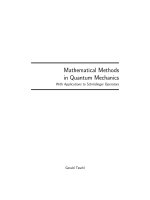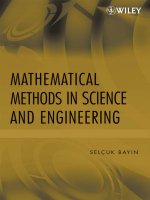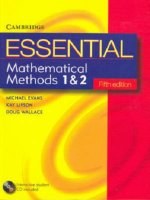- Trang chủ >>
- Khoa Học Tự Nhiên >>
- Vật lý
Mathematical methods sadri hassani
Bạn đang xem bản rút gọn của tài liệu. Xem và tải ngay bản đầy đủ của tài liệu tại đây (8.4 MB, 253 trang )
SADRI HASSANI
www.pdfgrip.com
UNDERGRADUATE TEXTS IN CONTEMPORARY PHYSICS
Series Editors
John P. Ertel
Robert C. Hilborn
David Peak
Thomas D. Rossing
Cindy Schwarz
Springer
New York
Berlin
Heidelberg
HongKong
London
Milan
Paris
Tokyo
www.pdfgrip.com
UNDERGRADUATE TEXTS IN CONTEMPORARY PHYSICS
Cassidy, Holton, and Rutherford, Understanding Physics
Enns and McGuire, Computer Algebra Recipes: A Gourmet's
Guide to the Mathematical Models of Science
Hassani, Mathematical Methods: For Students of Physics and
Related Fields
Hassani, Mathematical Methods Using Mathematica®:
Students of Physics and Related Fields
Holbrow,
Lloyd, and Amato,
For
Modern Introductory Physics
Moller, Optics: Learning by Computing, with Examples Using
Mathcad®
Roe, Probability and Statistics in Experimental Physics, Second
Edition
Rossing and Chiaverina, Light Science: Physics and the Visual
Arts
www.pdfgrip.com
MATHEMATICAL
METHODS USING
MATHEMATICA®
For Students of Physics
and Related Fields
Sadri Hassani
With 93 Illustrations and a CD-ROM
Springer
www.pdfgrip.com
Sadri Hassani
Campus Box 4560
Department of Physics
Illinois State University
Normal, IL 61790-4560
USA
Series Editors
John P. Ertel
Department of Physics
United States Naval Academy
572 Holloway Road
Annapolis, MD 21402-5026
USA
Robert C. Hilborn
Department of Physics
Amherst College
Amherst, MA 01002
USA
David Peak
Department of Physics
Utah State University
Logan, UT 84322
USA
Thomas D. Rossing
Science Department
New Trier High School
Winnetka, IL 60093
USA
Cindy Schwarz
Department of Physics
Northern Illinois University
De Kalb, IL 60115
USA
COVER ILLUSTRATI00f: Gradient or differentiation with respect to distance is shown in
two dimensions; the surface represents a function of x and y; the gradient is a vector in the
xy-plane.
Library of Congress Cataloging-in-Publication Data
Hassani, Sadri.
Mathematical methods using Mathematica: for students of physics and related fields/
Sadri Hassani.
p. em. - (Undergraduate texts in comtemporary physics)
Includes bibliographical references and index.
ISBN 0-387-95523-2 (softcover: alk. paper)
1. Physics-Mathematical models. 2. Mathematical physics-Data processing.
3. Mathematica (Computer file) I. Title. II. Series.
QC20 .H393 2002
530'.0285'53042-dc21
2002070732
ISBN 0-387-95523-2
Printed on acid-free paper.
Mathematica is a registered trademark of Wolfram Research, Inc.
© 2003 Springer-Verlag New York, Inc.
All rights reserved. This work may not be translated or copied in whole or in part without the
written permission of the publisher (Springer-Verlag New York, Inc., 175 Fifth Avenue, New
York, NY 10010, USA), except for brief excerpts in connection with reviews or scholarly analysis. Use in connection with any form of information storage and retrieval, electronic adaptation,
computer sofrware, or by similar or dissimilar methodology now known or hereafter developed
is forbidden.
The use in this publication of trade names, trademarks, service marks, and similar terms, even
if they are not identified as such, is not to be taken as an expression of opinion as to whether
or not they are subject to proprietary rights.
Printed in the United States of America.
9 8 7 6 5 432 1
SPIN 10881953
Typesetting: Pages created by the author in LaTeX 2e using Springer's svsing2e.sty macro.
www.springer-ny.com
Springer-Verlag New York Berlin Heidelberg
A member of Bertelsmannbprmger Science+Business Media GmbH
www.pdfgrip.com
To my wife, Sarah,
and to my children,
Dane Arash and Daisy Bita
www.pdfgrip.com
www.pdfgrip.com
Preface
Over two years have passed since the publication of Mathematical Methods, my undergraduate textbook to which the present book was to be a
companion. The initial motivation for writing this book was to take some
examples from Mathematical Methods in which to illustrate the use of a
symbolic language such as Mathematica®. However, after writing the first
few pages, I realized very quickly that, for the book to be most effective, I
had to go beyond the presentation of examples. I had to talk about the theory of numerical integration, discrete differentiation, solution of differential
equations, and a number of other topics; thus the delay in the publication
of the book.
As a result, the book has become a self-contained introduction to the
use of computer algebra-specifically, Mathematica-for undergraduates in
physics and related fields. Although many of the examples discussed here
are taken from Mathematical Methods, no prior knowledge of the content
of that book is essential for learning the techniques of computer algebra.
Of course, a deeper understanding of the underlying physical ideas requires
reading the relevant sections of Mathematical Methods or a book like it. For
those interested in the underlying theories of the examples being discussed,
I have placed the appropriate page (or section) numbers in the margin.
I have to emphasize that the book does not discuss programming in
Mathematica. Nor does it teach all the principles and techniques of the
most elegant utilization of Mathematica. The book can best be described
as "learning the essentials of Mathematica through examples from undergraduate physics." In other words, Mathematica commands and techniques
are introduced as the need arises.
www.pdfgrip.com
viii
Preface
I believe that some understanding of the theory behind the numerical
calculations is important, especially if it can invoke some Mathematica
usage. Therefore, I have included an entire chapter on the theory of the
numerical solutions of differential equations, and a rather lengthy discussion
on the theory behind numerical integration. In both discussions I make use
of Mathematica to enhance the understanding of the theories.
After introducing the essential Mathematica commands in Chapter 1,
I introduce vectors-using the calculation of electric fields and potentials
of discrete charge distributions-and matrices-using the calculation of
normal modes of mass-spring systems-in Chapter 2 as they are used in
Mathematica. Chapter 3 discusses numerical integration and a variety of
its applications in different physical settings such as the evaluation of electric, magnetic, and gravitational fields of various sources. Infinite series
and finite sums are the subject of Chapter 4, in which the theory of numerical integration is used as a nice example of the use of summation in
Mathematica. Chapter 5 is devoted entirely to a theoretical treatment of
the numerical solution of differential equations, discussing such techniques
as the Euler methods, the Runge-Kutta method, and the use of discrete
differentiation in solving eigenvalue problems. In Chapter 6, I have chosen some examples from classical and quantum mechanics to illustrate how
Mathematica solves ordinary differential equations.
This book can be used in conjunction with any undergraduate mathematical physics book. Many problems are inherently interesting but cannot
be solved analytically. Once the student learns the theory and formal mathematics behind a concept and solves a number of simple and ideal examples
analytically, he or she ought to be exposed to problems arising from realworld applications. Mathematica (or any other computer-algebra software)
can be of tremendous help in treating such problems and exhibiting their
solutions graphically (or otherwise). However, Mathematica has its greatest impact on the process of learning only if the student has completed
the preliminary stage of deeply understanding the analytical methods of
solution.
This is hardly the place to enter into the controversy surrounding the role
of content and memorization in learning. However, as an educator witnessing the alarming rate at which calculators and computer-algebra software
are substituting the learning of physics and mathematics, I feel obligated
to emphasize the distinction between the real utility of technology and its
advertised glamour. Technology can be a great tool of learning and teaching
once students acquire a certain degree of mathematical maturity. And this
maturity can be obtained only through a rigorous training in conventional
mathematics that emphasizes content at all levels of a student's education.
The neglect of content-such as the multiplication table at the elementary level, and algebraic/trigonometric identities at the high school levelcan have a detrimental effect on the mathematical and analytical ability
of the pupil's mind. If the educators sequentially postpone the "memoriza-
www.pdfgrip.com
Preface
ix
tion" of the multiplication table, algebraic and trigonometric identities, and
differentiation and integration rules, arguing that such "facts" are always
available on calculators and computers, then students will develop the skill
of "pushing buttons" beautifully but will be incapable of doing the simplest
integration. Some educators argue that lack of ability to multiply, integrate,
or simplify an algebraic expression is not a drawback as long as there are
calculators to do the job. To this I have to respond that heavy reliance
on calculating machines does to the mind what heavy reliance on vehicular
machines does to the body: it makes the mind lazy and inactive. Our minds
need raw data-in the form of numbers and symbols in conjunction with
the rules that manipulate them-to develop. A mind without data is like a
symphony without notes, an opera without lyrics, a poem without words. I
sincerely hope that the readers and users of this book will take this advice
to heart.
Sadri Hassani
Campus Box 4560
Department of Physics
Illinois State University
Normal, 1L 61790-4560, USA
e-mail:
www.pdfgrip.com
www.pdfgrip.com
Nate to the Reader
I should point out from the very beginning that, as powerful as Mathematica is, it is only a tool. And a tool is more useful if its user has thought
through the details of the task for which the tool is designed. Just as one
needs to master multiplication-s-both conceptually (where and how it is
used) and factually (the multiplication tablej-i-before a calculator can be
of any use, so does one need to master algebra, calculus, trigonometry, differential equations, etc., before Mathematica can be of any help. In short,
Mathematica cannot think for you.
Once you have learned the concepts behind the equations and know how
to set up a specific problem, Mathematica can be of great help in solving
that problem for you. This book, of course, is not written to help you set
up the problems; for that, you have to refer to your physics or engineering
books. The purpose of this book is to familiarize you with the simple~
but powerful-s-techniques of calculation used to solve problems that are
otherwise insoluble. I have taken many examples from your undergraduate
courses and have used a multitude of Mathematica techniques to solve those
problems.
I encourage you to explore the CD-ROM that comes with the book.
Not only does it contain all the codes used in the book, but it also gives
many explanations and tips at each step of the solution of a problem. The
CD-ROM is compatible with both Mathematica 3.0 and Mathematica 4.0.
www.pdfgrip.com
Mathematica, like any
other calculational tool,
is only as smart as its
user can make it!
www.pdfgrip.com
Contents
Preface
vii
Note to the Reader
xi
1 Mathematica in a Nutshell
1.1 Running Mathematica
.
1.2 Numerical Calculations
.
1.3 Algebraic and Trigonometric Calculations
1.4 Calculus in Mathematica .
1.5 Numerical Mathematics
1.6 Graphics
.
1.6.1 Simple Plots ..
1.6.2 Parametric Plots
1.6.3 Contour and Density Plots
1.6.4 Three-Dimensional Plots.
1.7 Complex Numbers
.
1.7.1 An Example from Optics
1.8 Animation.........
1.9 Input and Output Control .
1.10 Problems
.
2 Vectors and Matrices in Mathematica
2.1 Electric Fields.
2.2 Ionic Crystals . . . . . . . . . . . . . .
www.pdfgrip.com
1
1
2
4
8
13
18
18
19
22
23
26
28
36
41
43
49
49
54
xiv
Contents
2.3
2.4
2.5
2.6
2.7
2.2.1 One-Dimensional Crystal .
2.2.2 Two-Dimensional Crystal .
2.2.3 Three-Dimensional Crystal
Tubing Curves
Matrices..............
Normal Modes
.
2.5.1 A System of Two Masses
2.5.2 A System of Three Masses.
2.5.3 A System of Five Masses .
Normal Modes of a System of n Masses
Problems
.
54
56
58
60
66
70
70
73
75
78
82
3
Integration
85
3.1 Integration in Mathematica . . . . . . . . . . . . . . . . .. 86
3.1.1 The Simple Example of a Pendulum . . . . . . . .. 86
3.1.2 Shortcomings of Numerical Integration in Mathematica 87
3.1.3 Other Intricacies of Integration in Mathematica
89
3.2 Integration in Mechanics. . . . . .
91
3.2.1 Position-Dependent Forces
91
3.2.2 Gravitational Fields
95
3.3 Integration in Electrostatics
106
3.3.1 Potential of a Ring.
108
109
3.3.2 Potential of a Spiral
3.3.3 Flat Surface Charge Distributions
109
3.4 Integration in Magnetism . . . . . .
110
3.4.1 Circular Loop. . . . . . . . .
111
112
3.4.2 Current with General Shape.
3.4.3 Solenoid............
113
3.4.4 Rotating Charged Spherical Shell .
115
118
3.4.5 Rotating Charged Hollow Cylinder
3.5 Problems
120
4
Infinite Series and Finite Sums
4.1 Infinite Sequences
.
4.2 Numerical Integration
.
4.2.1 The Simplest Method
4.2.2 Trapezoid Rule . . .
4.2.3 Simpson's Rule . . . .
4.2.4 Gaussian Integration .
4.3 Working with Series in Mathematica
4.4 Equations Involving Series .
4.5 Fourier Series
4.6 Problems
.
www.pdfgrip.com
125
125
128
129
130
132
134
138
140
146
150
Contents
xv
5 Numerical Solutions of ODEs: Theory
155
5.1 Various Euler Methods. . . . .
156
5.1.1 Euler Method. . . . . .
156
157
5.1.2 Modified Euler Method
5.1.3 Improved Euler Method
157
5.1.4 Euler Methods in Mathematica
158
5.1.5 Alternative Derivation of the Improved Euler Method 161
5.2 The Kutta Method. . . . .
162
5.3 The Runge-Kutta Method.
164
168
5.4 Higher-Order Equations . .
5.5 Eigenvalue Problems . . . .
170
5.5.1 Discrete Differentiation
171
5.5.2 Discrete Eigenvalue Problem
173
5.6 Problems
173
6 Numerical Solutions of ODEs: Examples Using Mathemat~a
177
6.1 Some Analytic Solutions . . . .
177
6.2 A One-Dimensional Projectile.
180
6.3 A Two-Dimensional Projectile.
185
6.4 The Two-Body Problem . . . .
191
6.4.1 Precession of the Perihelion of Mercury
196
6.5 The Three-Body Problem . . . . . . .
198
6.5.1 Massive Star and Two Planets
198
6.5.2 Light Star and Two Planets . .
200
6.6 Nonlinear Differential Equations . . .
202
6.7 Time-Independent Schr6dinger Equation.
210
6.7.1 Infinite Potential Well
211
6.7.2 The General Case ..
216
6.7.3 Finite Potential Well.
218
6.7.4 Harmonic Oscillator
221
6.8 Problems
223
References
227
Index
229
www.pdfgrip.com
www.pdfgrip.com
1
Mathematica In a Nutshell
Mathematica® is a high-level computer language that can perform symbolic, numerical, and graphical manipulation of mathematical expressions.
In this chapter we shall learn many ofthe essential Mathematica commands.
1.1
Running M athematica
Installing and running M athematica differ from one computer system to
another. However, the heart of Mathematica, where the calculations are
performed, is the same in all systems. Mathematica has two major components, the kernel and the front end. The front end is the window in
which you type in your commands. These windows are generally part of
notebooks, which are Mathematica's interface with the kernel. The kernel is where the commands are processed. It could reside in the computer
where the front end resides, or it could be in a remote computer.
Mathematica is launched by double-clicking on its icon-or any other
shortcut your computer system recognizes. Almost all front ends now incorporate notebooks, and I assume that the reader is communicating with
Mathematica through this medium. The window of a notebook looks like
any other window. After typing in your command, hold down the Shift
key while hitting the Return key to execute that command. In Macintosh,
the numeric Enter key will also do the job.
When you enter a command, Mathematica usually precedes it with an
input sign such as In [1] : =; and when it gives out the result of the calcu-
www.pdfgrip.com
of kernels, front ends,
and notebooks
Shift+Return or
numeric Enter tells
Mathematica to start.
1. M athematica in a Nutshell
4
In [6J : = N[Sqrt [2] ,45]
Out[6J= 1.41421356237309504880168872420969807856967188
Reusing the existing
expressions
Mathematica has a very useful shortcut for reusing the existing expressions.
Typing in %-2 squares the last result generated and returns its value. Similarly, Sqrt [% 6] takes the square root of the result on output line Out [6] .
1.3
Algebraic and Trigonometric Calculations
The most powerful aspect of Mathematica is its ability to handle symbolic
mathematics, including all the manipulations one encounters in algebra.
The following is a partial list of algebraic expressions frequently encountered in calculations.
Mathematica allows a convenient method of substituting values for a
quantity in an expression:
Here is an example of the use of some of the above:
In[1J:= x-2-2x+1 /. x -> 2 + Y
Out[1J= 1 - 2(2
+ y) + (2 + y)2
In[2J:= Expand[%]
www.pdfgrip.com
1.3 Algebraic and Trigonometric Calculations
Out[2J= 1 + 2y
5
+ y2
In[3J:= Factor[%J
Out[3J= (1+y)2
As "smart" as Mathematica is, it is too ignorant to do some of the most
obvious things. You will have to ask it to do it. Consider the following:
In[4J:= g=x-2 + y-2
Out [4 1J= x 2 + y2
In[SJ:= g/. {x->Cos[tJ ,y->Sin[tJ}
Out Ib}> Cos[t]2
+ Sin[t]2
In[6J:= TrigReduce [gJ
Out[6J= x 2 + y2
In [7J : = TrigReduce [%5J
Out [7J= 1
This example illustrates a number of Mathematica subtleties that are
worth mentioning at this point. First, note that the substitution x->Cos [tJ
and y->Sin [t ] did not change the value of g, as evident in Out [6J. Second, Mathematica does not automatically "remember" even the simplest
trigonometric identity, if you do not "remind" it of the identity. Third,
Mathematica has some trigonometric "reminders," some of which are gathered below:
Here is an illustration of how these work:
In[8J:= TrigExpand[Sin[x+yJJ
Out[81J=
Cos[y] Sin [x]
+ Cos [x] Sin[y]
In[9J:= h=% /. {y->2x}
Out[9J=
Cos[2x] Sin [x]
+ Cos [x] Sin[2x]
www.pdfgrip.com
some trigonometric
commands
6
1. Mathematica in a Nutshell
InDO] ;= TrigExpand [h]
Out [10]= 3 Cos[xj2 Sin[x] - Sin[xp
In[ll] := TrigFactor [%]
OutD1]= (1 + 2 Cos[2x]) Sin[x]
In [12] := Tr i glcsduce [%]
Out [12]= Sin[3x]
For most purposes, the commands discussed so far are adequate. However, sometimes-especially with rational expressions-other commands
may come in handy. The following are examples of such commands:
Let us look at an example. Consider the rational expression
Out [1] :=
+ 6x 2 - x 3 + 2x 5
2 + 3x - 4x 2 + 6x 3
3- x
-
First we separate
f into terms with simple denominators:
In [2] ;= g=Apart [f ]
Out [2] :=
5
-27
2x
x2
71
+ 9 + 3 + 27(-2+3x)
Then we put them back together again:
In [3] ;= Together [g]
Out[3]:=
3 - x + x3
-2+3x
This is not f because, in the process of putting 9 together, Mathematica
simplified the expression, canceling out the common factors in the numerator and denominator. To see this, we reproduce f by typing it in:
www.pdfgrip.com
1.3 Algebraic and Trigonometric Calculations
7
In[4J;= f
Out[4J ;=
3 - x + 6x 2 - X 3 + 2x 5
-2 + 3x - 4x 2 + 6x 3
and ask Mathematica to cancel common factors in its numerator and denominator:
In[5J ; = Cancel [f ]
Out [5J;=
3 - x + x3
-2+3x
The following are some useful commands with which one can separate
different parts of an expression:
As an example, consider
In [1J ; = u= «x-2-2y+3) - 4 Tan [x]) / (x+Sin [3x] Cos [2y] )
Out[1J ;=
(x 2 - 2y + 3)4 Tan[x]
x + Cos [2y] Sin[3x]
Now isolate the numerator:
In[2J;= num=Numerator[u]
Out[2J ;=
(x 2
-
2y
+ 3)4 Tan[x]
Tell Mathematica to produce the (obvious) coefficient of Tan [x] :
In[3J;= Coefficient [num, Tan[x]]
Out[3J;=
(x 2
-
2y
+ 3)4
That was easy, But the following is not!
www.pdfgrip.com
1. Mathematica in a Nutshell
8
In[4]:= Coefficient[%, y-2]
Out [4] :=
216
+ 144x 2 + 24x 4
Now type in
In[5]:= TrigExpand[Denominator[u]]
Out[5]:=
+ 3 Cos[x]2 Cos[y]2 Sin[x] - Cos[y]2 Sin[x]3
- 3 COS[x]2 Sin [x] Sin[y]2 + Sin [x] 3 Sin[y]2
x
To find the coefficient of sin x type in
In[6]:= Coefficient[%, Sin[x]]
Out[6]:=
3 COS[x]2 Cos[y? - 3 Cos[x]2 Sin[y]2
1.4
Calculus in Mathematica
The ability to combine algebraic, trigonometric, and analytic calculations
makes M athematica an extremely powerful tool. It has the following commands for differentiation of a function:
When the function depends on a single variable, the following abbreviationscommon in mathematical literature-can be used:
www.pdfgrip.com
1.4 Calculus in Mathematica
9
Mathematica can differentiate simple expressions
Out [1]= 2x
as easily as some not-sa-simple ones:
In[2]:= D[Sin[x*y-2/Exp[x+y]] ,x,y]
Out [2] =
-
(2E~x-yy- 2E-x-y xy- E-x- Yy2+ E:":» xy2)Cos[E-x-y xy2]
(2E-x~y xy- E-x-y xy2) (E-x- Yy2 -
E-x-Yxy2)Sin[E-X-Y xy2]
Mathematica can perform definite and indefinite integration using its
enormous table of integrals as well as powerful internal routines. The symbol for integration commands are very intuitive:
Mathematica knows the elementary indefinite integrals
In [3] : = Integrate [x-2 Log [x] , x]
and some famous definite integrals:
Inf4.]:= Integrate [Exp [-x-2] , {x,
Out[4]=
v:
°,Infinity}]
It is familiar enough with some famous functions to give the result of some
integrations in terms of them:
In[5]:= Integrate[Sqrt[l-k Sin[x]-2] ,x]
Out[5]= EllipticE[x,k].
However, it cannot evaluate all integrals analytically:
In[6]:= Integrate[x-x],{x,O,l}]
Out[6]=
1
f0 XX
dx
www.pdfgrip.com









